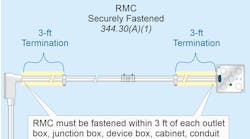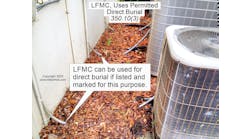Q. What wiring methods does the NEC permit in a Class I, Div. 1 location?
Find the Answer
A. Only the following wiring methods are permitted in a Class I, Div. 1 location [501.10(A)]:
(a) Threaded rigid metal conduit (RMC) or intermediate metal conduit (IMC) with explosionproof fittings.
(b) Mineral insulated (MI) cable terminated with fittings listed for the location.
(c) In industrial establishments with restricted public access where only qualified persons will service the installation, MC-HL cable listed for use in Class I, Zone 1, or Division 1 locations, with a gas/vaportight continuous corrugated metallic sheath, an overall jacket of suitable polymeric material, a separate equipment grounding conductor(s) in accordance with 250.122, and terminated with fittings listed for the application. Such cable must comply with Part II of Art. 330.
(d) In industrial establishments with restricted public access where only qualified persons will service the installation, ITC-HL cable terminated with fittings listed for the location.
Explosionproof flexible metal connections listed for the location are permitted in a Class I, Div. 1 location when necessary for vibration, movement, or flexible cords for difficult bends in accordance with 501.140 if terminated with cord connectors listed for the location [501.10(A)(2)].
Boxes and fittings must be approved by the authority having jurisdiction (AHJ) for Class I, Div. 1 locations [501.10(A)(3)].



